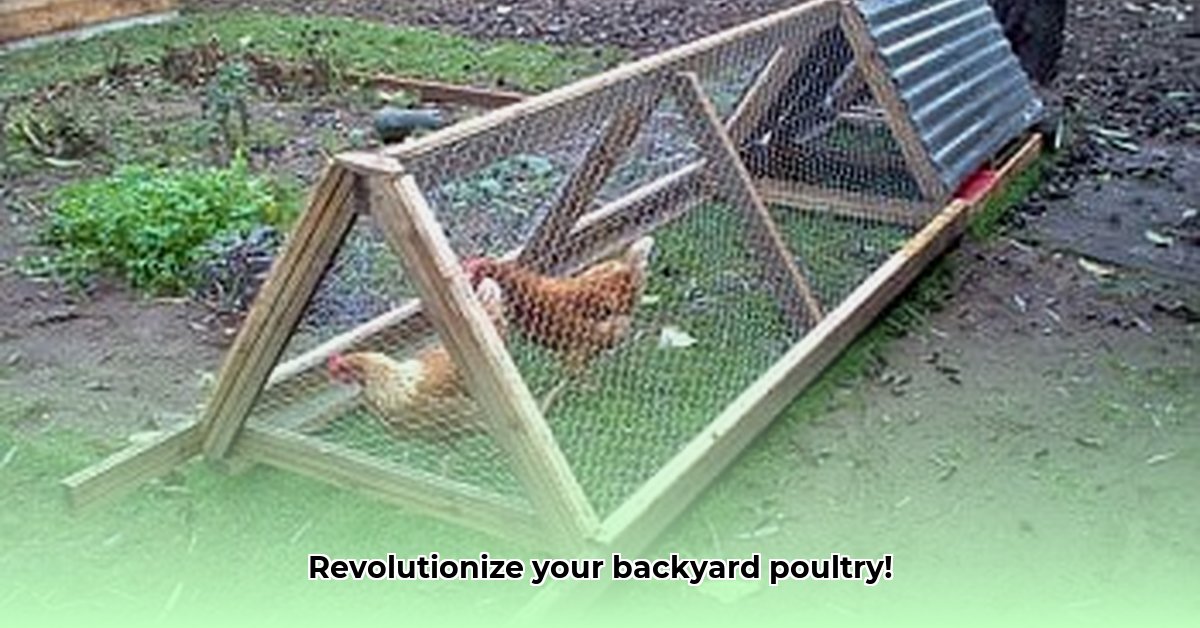
Understanding Chicken Tractors: Mobile Coops for Happy, Healthy Hens
Chicken tractors are mobile coops designed to improve the lives of your chickens and the health of your land. Think of them as a mobile buffet and fertilizer factory, all in one! The images you've likely seen showcase diverse designs, from simple wooden structures to more elaborate models. Regardless of the design, the core principle remains: mobility. This allows you to regularly move your flock to fresh pastures, preventing overgrazing and improving soil health. A well-designed chicken tractor offers several key features: mobility (wheels or skids), ample space per bird (at least 10 square feet is recommended), robust predator protection, and convenient access for cleaning and egg collection. For more design ideas, check out these chicken tractor plans. Isn't it fascinating how such a simple concept can have such a significant impact?
Planning Your Chicken Tractor System: A Step-by-Step Guide
Building or buying a chicken tractor is a rewarding project, but careful planning is essential. Let's break it down into manageable steps:
1. Site Selection and Preparation:
- Assess your pasture: How much space do you have? Is there sufficient area for successful rotation? Consider soil type for drainage and nutrient levels. Will adequate sunlight reach your chosen area?
- Prepare the ground: Remove any debris, rocks, or hazards that could harm your chickens. Establish a perimeter fence to keep your birds securely within the designated area.
2. Choosing or Building Your Tractor:
- Purchasing pre-fabricated: Ready-made tractors provide convenience but can be expensive. Online retailers and agricultural supply stores offer a variety of options.
- DIY construction: Building your own tractor is cost-effective and allows for customization. Numerous online resources provide detailed plans and instructions. This could be a fun project for DIY enthusiasts.
3. DIY Chicken Tractor Construction (Simplified Overview):
While detailed plans with images would be ideal, we'll provide a simplified overview:
- Frame Construction: Build a sturdy frame using pressure-treated lumber for longevity and durability. The strength of the frame is paramount for keeping predators at bay.
- Flooring & Walls: Utilize plywood or repurposed materials. Secure hardware cloth to create a predator-proof enclosure.
- Roof: Build a roof to provide shade and protection from harsh weather. This will enhance the comfort and safety of your flock.
- Doors & Access: Design easy-access doors for efficient feeding, cleaning, and egg collection.
- Wheels/Skids: Attach wheels or skids for easy maneuverability across your pasture.
4. Pasture Management and Rotation:
Regularly moving your chicken tractor is crucial for preventing overgrazing and parasite buildup. Efficient pasture rotation allows the land to recover, resulting in healthier soil. Creating a rotation schedule and meticulously monitoring your pastures is critical for maintaining this balance. How many days should you move the coop? This will depend on the size of both the tractor and pasture.
5. Predator Protection:
- Electric netting: A cost-effective solution that can deter many predators.
- Guardian animals: Guard dogs or other livestock can provide an additional line of defense.
- Secure construction: Use sturdy materials and secure latches to prevent access.
6. Manure Management:
Chicken manure is a valuable fertilizer! You can either allow it to naturally compost within the pasture or collect it for use in your garden. Proper manure management contributes significantly to the sustainability of your entire system. Isn't it incredible that waste can be converted into a valuable resource?
Chicken Tractor Maintenance and Operation: Daily Care for Happy Hens
Daily routines are essential for ensuring the well-being of your flock. Regularly inspect your tractor for damage, conduct frequent cleaning to maintain hygiene and prevent disease, and consistently monitor your chickens' health, looking for any signs of illness or distress. Moving the tractor, as discussed earlier, is a key element of maintaining a healthy and productive system.
Addressing Potential Challenges: Troubleshooting and Solutions
While chicken tractors offer considerable benefits, potential challenges require careful consideration:
| Challenge | Potential Solutions |
|---|---|
| Local Regulations and Permits | Contact your local authorities before commencing. Some jurisdictions have regulations regarding poultry. |
| Diseases and Parasites | Maintain stringent hygiene, practice sound biosecurity, consider vaccinations if needed, and monitor for illness. |
| Start-up Costs and Budgeting | Create a detailed budget that incorporates material costs, potential feed costs, and potential income from eggs or meat. |
| Scaling Up Your Operation | Start with a smaller-scale operation to gain experience and then expand gradually as needed. |
Remember, the images of chicken tractors only represent the structure; the true success lies in sustainable practices and proactive problem-solving. With careful planning and dedication, you can enjoy the rewards of raising healthy chickens while promoting environmental sustainability.